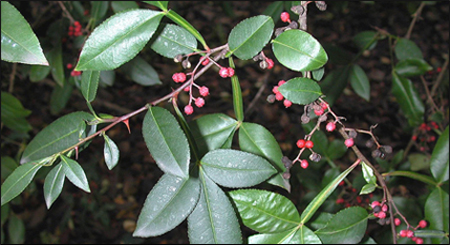Tumbru / Tejovati (Zanthoxylum armatum) – Uses, Benefits, Dosage and Properties
Abstract
Zanthoxylum armatum DC., commonly known as the “toothache tree” or “timur,” is a medicinally significant plant belonging to the Rutaceae family. Widely distributed in the Himalayan region, this plant has gained prominence for its diverse pharmacological properties and traditional uses in indigenous medicine. Known for its aromatic fruits and sharp thorns, Zanthoxylum armatum DC. has been used for centuries to treat various ailments such as dental pain, digestive issues, fever and skin disorders. This article explores the botanical characteristics, ethnomedicinal uses, phytochemical constituents, pharmacological properties and conservation concerns associated with Zanthoxylum armatum DC., highlighting its importance in modern herbal medicine and the need for sustainable utilisation.

Introduction
Zanthoxylum is a highly valued herb in Ayurveda, renowned for its wide range of medicinal properties used in the treatment of various health disorders. Its fruits, bark and seeds are key ingredients in numerous Ayurvedic formulations. Traditionally, the young and soft twigs of this plant have been used as a natural remedy for bleeding gums and dental caries. In local traditions, especially in Ayurvedic and traditional Chinese medicine, it is used extensively for its therapeutic potential. Its fruits, seeds, bark and leaves have been integral in folk remedies, while its essential oils have shown strong antimicrobial and insecticidal activities. The essential oil extracted from its fruits enhances its utility in the production of cosmetics, deodorants and oral care products.
Scientific Classification
- Kingdom: Plantae
- Phylum: Streptophyta
- Class: Equisetopsida
- Order: Sapindales
- Family: Rutaceae
- Genus: Zanthoxylum
- Species: aramatum
Synonyms
- Tejovati (Due to pungent taste)
- Tumbaru (Aromatic Fruit)
- Tejohwa (Due to Bitter taste)
- Vanaja (Wild habitat)
- Saurabha (Aromatic Fruit)
Vernacular Names
- Hindi – Tejphal, Tumabru
- English – Toothache tree
- Nepali – Timur
- Tamil – Timur
- Chinese – Tengjiao
- Punjabi – Tejbal
- Bengali – Tejowati
- Marathi – Tumbara
- Kannada – Tumburi
- Telugu – Tumburu
- Sanskrit – Tumbru, Tejovali, Tejovaha
- Bengali – Tejovati, Nepalidhania
- Assamese – Tejovati
- Gujarati – Tejbal
- Oriya – Tejbal
- Thailand – Makkak
- Malayalam – Thumbooni
- Garhwali – Tejbal
Habitat
Zanthoxylum is primarily native to North America, but it is widely distributed across Northeast India, extending from Kashmir to Bhutan. It is also found in several other countries, including Nepal, China, the Philippines, Malaysia, Pakistan, Taiwan and Japan.
Morphology
Zanthoxylum is an evergreen, deciduous, thorny shrub or small tree, typically growing to a height of 20 feet or more. Leaves are alternate and compound, usually pinnate with 5 to 11 leaflets. Leaflets are ovate to lanceolate, entire or slightly serrated and aromatic when crushed. Flowers are small and greenish-yellow. The fruit is a reddish-brown to blackish capsule, usually globose or ovoid and aromatic. When mature, the fruit splits open (dehiscent) to expose shiny black seeds. The surface of the fruit is often rough or warty due to oil glands. Seeds are round, smooth and black, enclosed singly in each capsule. The root system is woody and deep, anchoring the plant firmly in rocky or forested soils.
Varieties
- One type of Tumburu is found in South India and Assam. It is called Tirphal or Chirphal. Its Latin name is Zanthoxylum limonella. Its fruit is larger than Tumburu.
- There is another fruit tree which resembles Tejbal is Zanthoxylum acanthopodium DC.
Classical Categorisation
- According to Charaka – Shirovirechana (Herbs used for Nasya) , Katuskandha (Herbs having pungent taste)
- According to Bhavprakash Nighantu – Haritkyadi Varga
Ancient Verses
तेजस्विनी कफश्वासकैसास्यामयवातहृत |
पाचन्युष्णाकटुस्तिक्तारूचिवह्निप्रदीपनी ||
(Bhavprakash Nighantu Haritakyadi varga 170)
According to the above Shloka, the Toothache plant is effective in cough, asthma, balancing Vata dosha and mouth disorders. It contains hot potency, bitter and pungent taste, appetising and digestive properties and increases digestive fire.
Ayurvedic Properties
- Taste (Rasa) – Bitter (Tikta), Pungent (Katu)
- Physical property (Guna) – Light (Laghu), Sharp (Teekshna)
- Potency (Veerya) – Hot Potency (Usna)
- Post-digestion effect (Vipaka) – Katu (Pungent)
- Effect on tridosha – Balances Vata and Kapha dosha
Therapeutic Properties
- Digestive (Pachaka)
- Appetiser (Ruchikarka)
- Increases digestive fire (Agnideepaka)
- Kasa (Cough)
- Shvasa (Asthma)
- Toothache (Dantshoola)
- Effective in mouth diseases
Systemic Actions
External Uses
Its powder is effective in case of wounds. Its paste is applied to the forehead in case of a headache. Local application is really effective in mouth disorders.
Internal Uses
- Nervous system – It helps to pacify Vata dosha and is indicated in Amavata, hemiplegia, etc. It acts as a nerve stimulant.
- Digestive system – Its fruit is used in case of tooth diseases. It is indicated in loss of appetite, indigestion, diarrhoea, hepato-splenomegaly, helminthiasis, etc.
- Circulatory System – It acts as a Cardiac stimulant and helps in heart diseases.
- Respiratory System – As it helps in pacifying Kapha dosha, so indicated in Cough and asthma.
- Excretory System – It helps in increasing urine production and is indicated in painful urination.
Chemical Composition
- Berberine
- Dictamnine
- Magnofluorine
- Xanthoplanine
- Skimmianine
- Xanthyletin
- Zanthoxyletin
- Eudesmin
- Alloxanthyletin
- Tambulin
- Fargesin
- Sesamin
Modern Overview
Antidiabetic Effects
In rats that had been given streptozotocin (60 mg/kg) to produce diabetes, the antidiabetic effect of a hydro-methanolic extract of the bark of Zanthoxylum armatum was examined. The normal reference medication was glibenclamide (5 mg/kg). The oral treatment of Zanthoxylum armatum hydro methanolic extract for 21 days (200 and 400 mg/kg) led to a substantial decrease in blood sugar, total cholesterol, triglycerides, LDL and VLDL, as well as a significant increase in HDL.
Hepatoprotective Activity
By bringing the increased levels of hepatic enzymes back to normal, Zanthoxylum armatum ethanolic extract showed hepatoprotective effects against carbon tetrachloride-induced liver injury. In comparison to silymarin, which is said to have a protective effect on the plasma membrane of hepatocytes, Zanthoxylum armatum ethanolic extract can condition the hepatocytes, protecting against membrane fragility and reducing the leakage of the marker enzymes into the circulation.
Practical Uses
- A decoction made from the bark and fruits of Tumburu is traditionally used as a digestive stimulant and is effective in managing conditions like fever, indigestion and cholera. It is also valued for its ability to help alleviate general weakness and restore vitality in the body.
- The smoke produced from burning the Tumburu herb is considered highly effective in the treatment of chronic asthma.
- A warm poultice made from fresh Tumburu leaves mixed with rice flour is traditionally applied to relieve excessive inflammation and pain in the neck and throat.
- Oil extracted from this herb possesses strong antiseptic and antimicrobial properties.
Part Used
- Bark
- Fruit
Dosage
Powder- 1-2 gm
Ayurvedic Medicines
- Tejovatyadi Ghrita
- Tumburvadi Churna
Conclusion
Zanthoxylum armatum (Tumburu) is a versatile and therapeutically valuable herb deeply rooted in Ayurvedic tradition. Its wide range of medicinal applications, from treating digestive and respiratory disorders to managing dental issues and skin conditions, highlights its significance in both traditional and modern herbal medicine. However, due to increasing demand and overharvesting, sustainable cultivation and conservation efforts are crucial to preserve this valuable medicinal resource for future generations.



